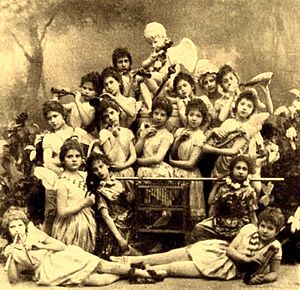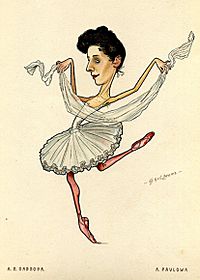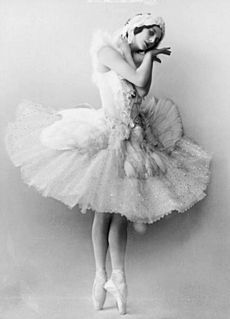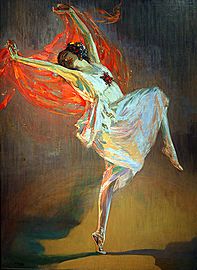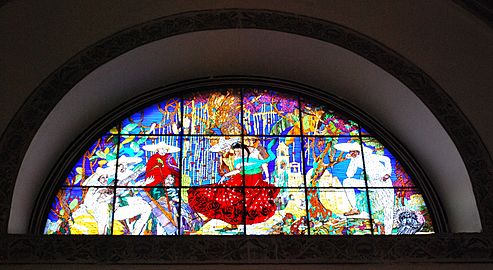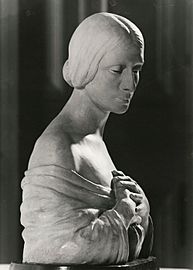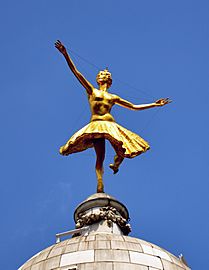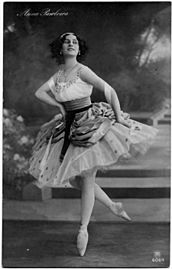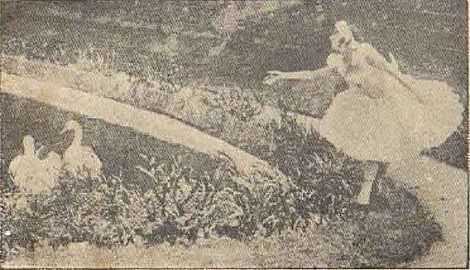Anna Pavlova facts for kids
Quick facts for kids
Anna Pavlova
|
|
|---|---|
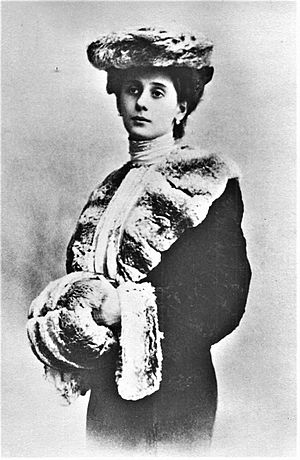
Pavlova, c. 1905
|
|
| Born |
Anna Matveyevna Pavlova
12 February 1881 |
| Died | 23 January 1931 (aged 49) The Hague, Netherlands
|
| Occupation | Ballerina |
| Years active | 1899–1931 |
| Spouse(s) |
Victor Dandré
(m. 1914) |
| Parent(s) |
|
Anna Pavlova (born Anna Matveyevna Pavlova; 12 February 1881 – 23 January 1931) was a famous Russian ballerina. She was one of the greatest ballet dancers of the late 1800s and early 1900s.
Anna was a main dancer with the Imperial Russian Ballet and the Ballets Russes. She is best known for creating the role of The Dying Swan. With her own dance company, she became the first ballerina to tour the world. She performed in places like South America, India, and Australia.
Contents
Anna Pavlova's Early Life
Anna Matveyevna Pavlova was born in Saint Petersburg, Russia. Her father, Matvey Pavlov, was a soldier. Her mother, Lyubov Feodorovna Pavlova, worked as a laundress.
Anna was born early and was often sick. She was sent to a village to live with her grandmother. Her love for ballet began when her mother took her to see The Sleeping Beauty. This beautiful show at the Imperial Maryinsky Theater deeply impressed her.
When she was nine, Anna tried out for the famous Imperial Ballet School. She was rejected because she was young and seemed sickly. But, at age 10, in 1891, she was accepted. Her first time on stage was in Un conte de fées. This ballet was created for the school's students.
Training at the Imperial Ballet School
Anna Pavlova's training years were tough. Classical ballet was not easy for her. Her feet were very arched, and her ankles were thin. Her body shape was different from what was popular for ballerinas then. Other students sometimes teased her.
But Anna was determined. She worked hard to improve her technique. She would practice a step over and over. She believed that talent alone was not enough. She said, "God gives talent, work transforms talent into genius." She took extra lessons from great teachers like Enrico Cecchetti. He was a famous ballet dancer and created the Cecchetti method, which is still used today.
In 1899, at age 18, she graduated. She joined the Imperial Ballet at a higher rank than most new dancers. Her first official performance was at the Mariinsky Theatre. Critics praised her performance.
Anna Pavlova's Ballet Career
Dancing in St. Petersburg
Anna Pavlova's dancing style was unique. She often bent her knees or had a different arm position. This was not the strict academic style of the time. Her style reminded people of older, romantic ballets.
Pavlova danced in many ballets. These included The Sleeping Beauty and The Pharaoh's Daughter. Sometimes, her energy caused her to lose balance. Once, she even fell into the prompter's box! Her weak ankles made some jumps difficult.
She quickly became a favorite of the ballet master, Marius Petipa. He taught her many important roles. She became a danseuse in 1902, a première danseuse in 1905, and a prima ballerina in 1906. This happened after her amazing performance in Giselle. Fans in Saint Petersburg loved her and called themselves the Pavlovatzi.
In 1901, another ballerina, Mathilde Kschessinska, coached Pavlova for the role of Nikiya in La Bayadère. Kschessinska thought Pavlova would fail because of her thin ankles. But audiences loved Pavlova's delicate and graceful look. It was perfect for the role, especially in the famous "Kingdom of the Shades" scene.
The Dying Swan
Pavlova is most famous for creating The Dying Swan. This solo dance was made for her by Michel Fokine in 1905. She danced it to music called Le cygne (The Swan) by Camille Saint-Saëns.
Pavlova also created some of her own solo dances. One was The Dragonfly, set to music by Fritz Kreisler. When she performed it, she wore a light dress with large dragonfly wings.
Working with Ballets Russes
For a short time, Pavlova worked with Sergei Diaghilev's Ballets Russes. She was supposed to dance the main role in The Firebird. But she didn't like the modern music by Igor Stravinsky. So, the role went to another dancer. Pavlova always preferred the older, more melodic ballet music.
Pavlova's Own Dance Company
Traveling the World
After performing in Paris, Pavlova started her own dance company. She traveled all over the world with it. Her company performed shorter versions of classic ballets. She also had new dances created just for her.
Pavlova learned and performed many 'ethnic' dances. She learned some from local teachers during her travels. Besides Russian dances, she performed Mexican, Japanese, and East Indian dances. She inspired Uday Shankar, her dance partner from India. He later helped bring back traditional dance in his home country. She also toured China.
In 1915, she appeared in a film called The Dumb Girl of Portici. She played a girl who could not speak.
Life in England
After leaving Russia, Pavlova moved to London, England, in 1912. She lived at Ivy House in Golders Green. The house had a lake where she fed her pet swans. A statue of her by George Henry Paulin now stands there. Ivy House was featured in a film about her life.
Pavlova helped British ballet grow. She especially inspired the famous ballerina Alicia Markova. There are several memorials to Pavlova in London. One is a statue on top of the Victoria Palace Theatre. This statue was taken down during World War II and lost. A new one was put in its place in 2006.
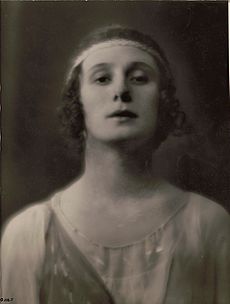
Tours in the United States
Between 1912 and 1926, Pavlova toured the United States almost every year. She traveled from one side of the country to the other.
In 1914, Pavlova performed in St. Louis, Missouri. Her performances were very popular and brought in a lot of money. People in St. Louis loved her shows.
Anna Pavlova's Personal Life
Victor Dandré, her manager, said he was her husband. They secretly married in 1914. He wrote a book about her life. Victor Dandré died in 1944. His ashes are placed below Anna's at Golders Green Crematorium.
Anna bought a home near Paris where 15 girls were adopted and cared for. She supported this home with her performances and donations.
She loved animals and had many pets. These included a Siamese cat, dogs, and many birds, including swans. Pictures of her often show her with her beloved animals.
Anna Pavlova's Death
While traveling from Paris to The Hague, Pavlova became very ill. Doctors told her she had pneumonia and needed surgery. They also said she might never dance again if she had the operation. She refused, saying, "If I can't dance, then I'd rather be dead." She died of pleurisy in The Hague, just 20 days before her 50th birthday.
Victor Dandré wrote that she died shortly after midnight on January 23, 1931. Her last words were, "Get my 'Swan' costume ready."
Following an old ballet tradition, the show went on as planned on the day she was supposed to perform. A single spotlight circled an empty stage where she would have been. Pavlova was cremated, and her ashes were placed at Golders Green Crematorium in London.
There have been discussions about moving her ashes back to Russia. However, there is no clear proof that this was her wish. Her ashes remain in London.
Anna Pavlova's Legacy
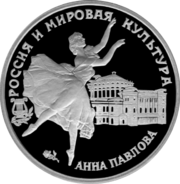
Pavlova inspired many people. The famous choreographer Frederick Ashton was inspired after seeing her dance when he was 13.
The delicious Pavlova dessert is named after her. Both New Zealand and Australia claim to have invented it!
Her dancing also inspired many artworks by the Irish painter John Lavery.
The Jarabe Tapatío, known as the "Mexican Hat Dance," became popular outside Mexico because of Pavlova. She created a version of it danced en pointe. Mexican audiences loved it so much they threw hats onto the stage. Later, in 1924, the Jarabe Tapatío became Mexico's national dance.
A type of algae called Pavlova is named after her. This is because its movement is "positively balletic."
In 1983, a film called Anna Pavlova was made about her life.
Pointe Shoes
Pavlova's feet were very arched. To help her dance en pointe, she made changes to her pointe shoes. She added a hard piece of leather to the soles for support. She also flattened the box of the shoe.
At the time, some dancers thought this was "cheating." They believed the dancer, not the shoe, should hold the weight en pointe. But for Pavlova, it was very hard to balance on her big toes. Her changes to the shoe became the start of the modern pointe shoe. This made dancing en pointe less painful for dancers with curved feet.
Choreographic Notation
Around the early 1900s, the Imperial Ballet started writing down its ballets using the Stepanov method. This helped preserve the dances. After the Russian Revolution, these notes were taken out of Russia. They were used to stage famous ballets like The Nutcracker and The Sleeping Beauty in other countries.
These notes are now at Harvard University. They include details about how Anna Pavlova danced some roles.
Anna Pavlova's Repertoire
Pavlova performed in many ballets. Here are some of her roles:
| Date | Ballet | Role(s) | Location | Notes |
|---|---|---|---|---|
| 1891 | A Fairy Tale | |||
| 1905 | The Dying Swan | Dying Swan | Saint Petersburg | |
| 1921 | La Péri (Dukas) | Peri | Paris | |
| Giselle | ||||
| La Camargo | ||||
| Les Dryades prétendues | Saint Petersburg | |||
| Le Roi Candaule | Queen Nisia | |||
| Marcobomba | ||||
| Paquita | Paquita | |||
| The Pharaoh's Daughter | Princess Aspicia, River Thames | |||
| The Sleeping Beauty |
Gallery
-
"Anna Pavlova as a Bacchante", by Sir John Lavery
-
The Butterfly (Costume Design by Léon Bakst for Anna Pavlova), Museum of Fine Arts, Boston
-
Pavlova in "La Fille mal gardée", 1912
See Also
 In Spanish: Anna Pávlova para niños
In Spanish: Anna Pávlova para niños
- List of dancers
- List of Russian ballet dancers
- Women in dance


